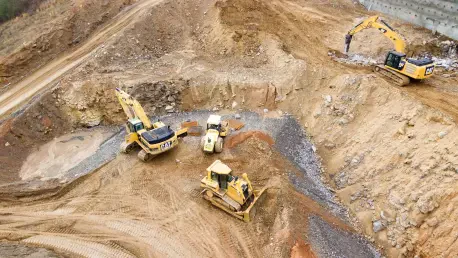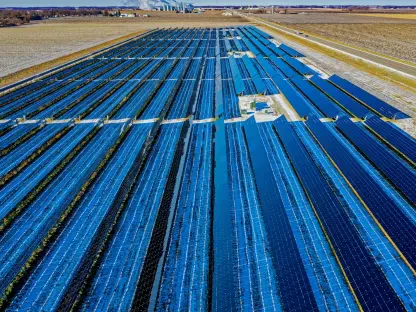Amid growing global concerns over climate change and calls for greener industrial practices, Hancock Iron Ore has embarked on a transformative journey. The company has set its sights on integrating renewable energy solutions into its mining operations in Pilbara, Western Australia. Over recent years, industries have felt mounting pressure to reduce their carbon footprint, and mining, notorious for high energy consumption and reliance on fossil fuels, has been at the forefront of this scrutiny. As mining companies strive to balance operational demands with environmental responsibility, Hancock Iron Ore emerges as a leader in innovation, embracing renewable energy to propel its operations into a cleaner, more sustainable future. This initiative, marked by the deployment of groundbreaking solar and battery storage systems, signals a pivotal shift towards eco-friendly processes in mining.
Innovative Hybrid Energy Systems
Harnessing Solar and Battery Power
Central to Hancock Iron Ore’s initiative is the strategic deployment of three hybrid solar and battery storage systems. Developed in partnership with Pacific Energy, these systems are designed to significantly enhance the sustainability of mining operations. The utilization of 750 kW of solar power, complemented by 1.68 MWh of battery storage, underscores a commitment to minimizing environmental impact. These systems are set to revolutionize how energy demands are met by powering crucial dewatering facilities. By reducing the reliance on traditional diesel fuel, the initiative not only lowers emissions but also promises substantial operational savings. The overarching objective is to achieve an impressive 55% renewable energy penetration, translating to a reduction in diesel consumption by up to 250,000 liters annually. The integration of cutting-edge technology ensures that energy requirements are not only met with precision but also contribute meaningfully to the decarbonization of the mining sector.
Modular Technologies for Remote Applications
Hancock Iron Ore’s innovative energy systems incorporate Australian manufacturer 5B’s preassembled Maverick modular solar technology, a noteworthy aspect of the project. This approach is pivotal, especially given the challenges associated with remote, off-grid mining sites. The modular design facilitates rapid deployment and transportation, crucial for operations in isolated regions. These preassembled units can be easily transported, installed, and maintained, streamlining the integration process. Pacific Energy highlights the efficiencies gained from this modular setup, pointing out the reduced need for extensive on-site construction and the manageable maintenance demands that follow testing. This not only enhances the overall operational efficiency but also plays a critical role in cutting back on fuel consumption. The adoption of these technologies represents a strategic decision to future-proof mining operations by aligning with global sustainability trends and environmental standards.
Regional Trends and Industry Impact
Decarbonization Shifts in Pilbara
The move towards renewable energy solutions is not unique to Hancock Iron Ore but part of a broader regional trend that spans the mining industry in Pilbara. Other major players like Fortescue and Rio Tinto are spearheading similar initiatives, underscoring an industry-wide shift towards decarbonization. These companies have begun investing heavily in solar projects, setting new benchmarks for sustainable mining practices. As solar technology becomes more accessible and cost-effective, its adoption across Pilbara’s mining landscape is accelerating. The rising trend reflects a collective commitment to reducing carbon footprints while ensuring energy security and sustainability. For mining companies in this region, transitioning to renewable energy is no longer just an environmental imperative; it has become a strategic necessity to remain competitive and compliant with evolving regulations and stakeholder expectations.
Consensus on Environmental Responsibility
The increasing focus on sustainable energy integration among mining companies highlights a significant evolution in industry outlook. Hancock Iron Ore’s ambitious initiative aligns with a growing consensus within the sector, emphasizing the need to address environmental impacts proactively. The transition towards renewables illustrates a broader acknowledgment of the long-term benefits associated with reducing reliance on fossil fuels. As these systems become more entrenched in day-to-day operations, the industry anticipates enhancements in operational efficiency and sustainability. Furthermore, the shift signals a prioritization of environmental stewardship, with mining companies taking tangible steps to lessen their ecological footprint. The developments in Pilbara serve as a microcosm of global efforts to embrace greener practices, setting a precedent for responsible mining in an era increasingly defined by climate consciousness.
Looking Ahead: The Road to Sustainability
Hancock Iron Ore’s pioneering efforts in adopting hybrid solar technology and battery storage systems marked a decisive step forward in sustainable mining. Through innovative approaches and strategic partnerships, the company set a new standard for industry responsibility. The projects underscored how renewable energy integration can serve as a catalyst for transformational change in energy-intensive sectors. Beyond immediate environmental benefits, the initiative highlighted a path toward long-term sustainability, energy independence, and reduced operational costs. The movement towards cleaner energy in mining operations prompted a re-evaluation of traditional practices, providing a blueprint for future endeavors in the sector. As the industry continued to shift towards greener solutions, the positive implications of these undertakings began to permeate various facets of mining, reinforcing a commitment to a more sustainable and responsible future.









